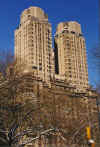 |
New York Architecture Images-Upper West Side THE CENTURY APARTMENTS |
|||
|
architect |
Irwin S. Chanin, Jacques Delamarre, Director and Sloan & Robertson | |||
|
location |
25 Central Park West | |||
|
date |
1931 | |||
|
style |
Art Deco | |||
|
construction |
steel frame with brick cladding | |||
|
type |
Apartment Building | |||
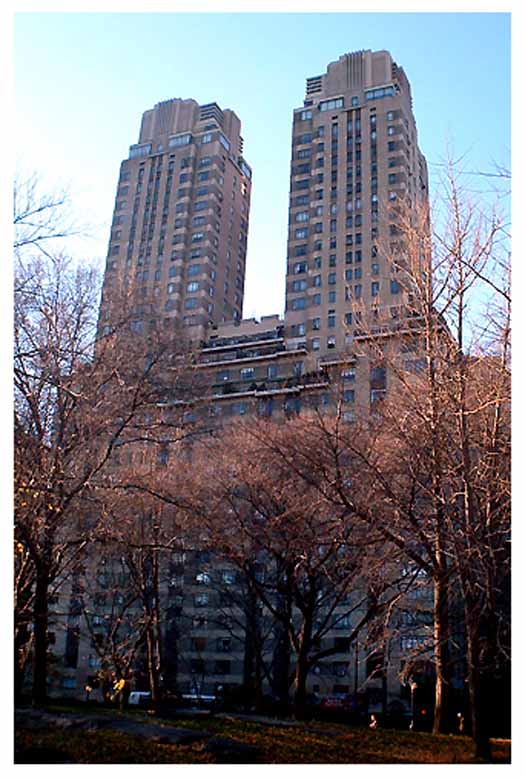 |
||||
|
|
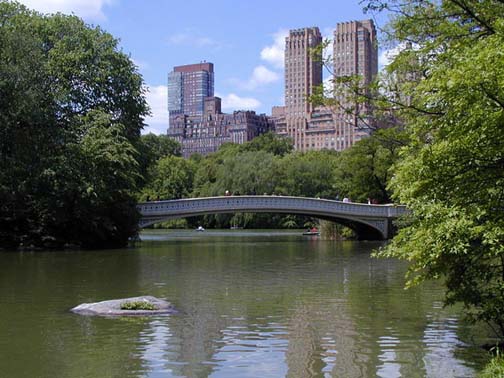 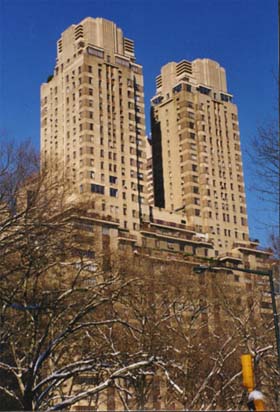 |
|||
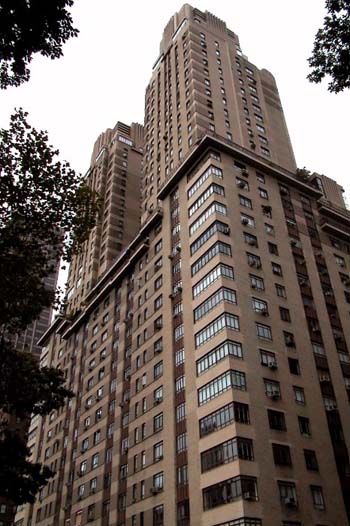 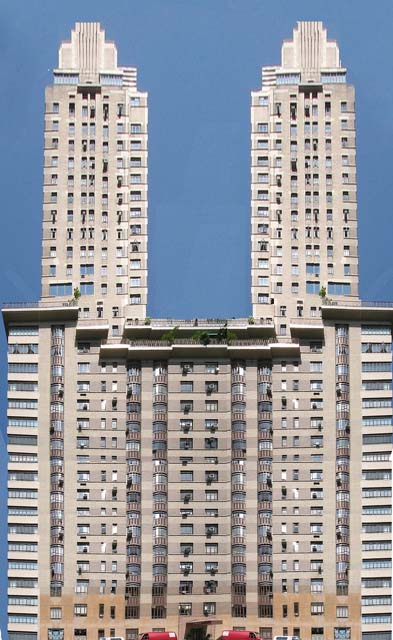 |
||||
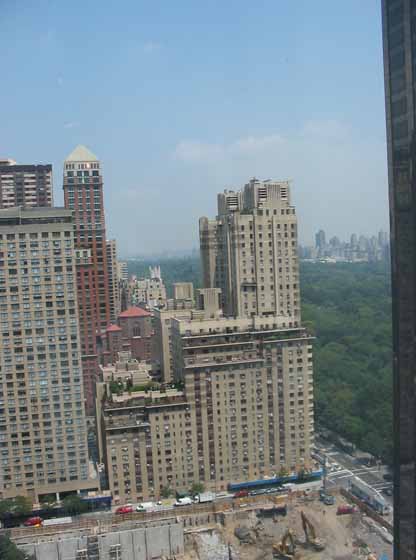 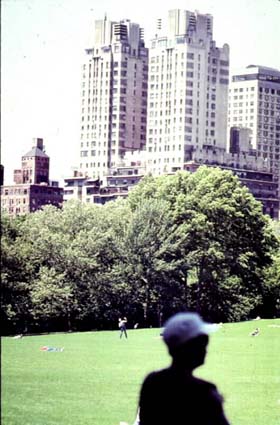 |
||||
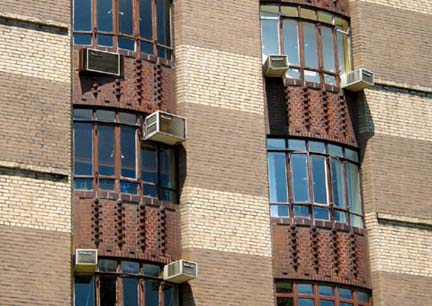 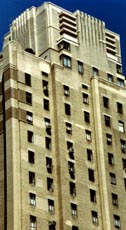 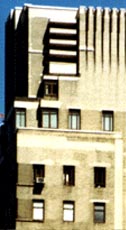  |
||||
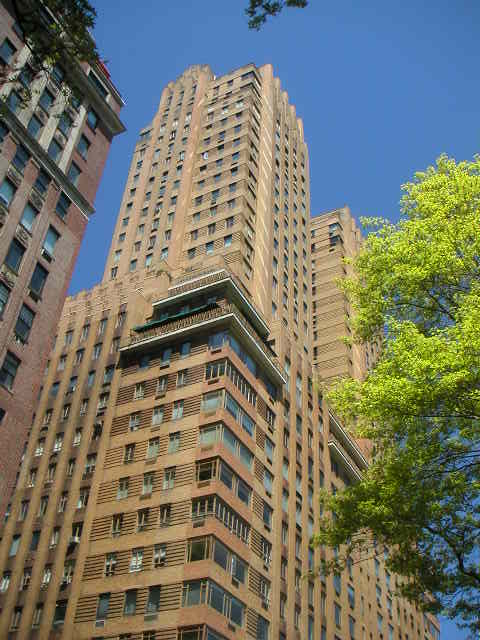 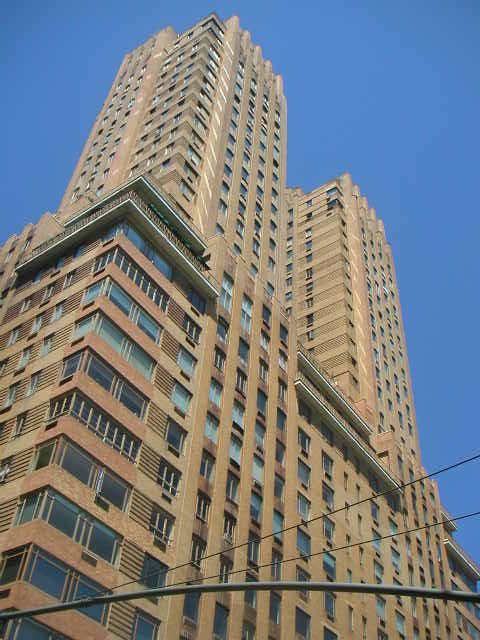 |
||||
|
|
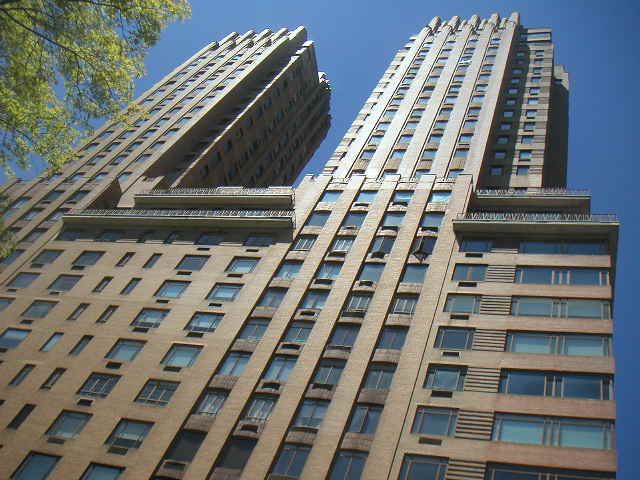 |
|||
|
The Century is a 1931 Art Deco apartment building located along Central
Park West in Manhattan, New York City. It was constructed at a cost of
$6.5 million dollars and designed by the firm owned by Irwin S. Chanin.
The Century apartment building is located on the former site of the
Century Theatre, which was demolished in 1930-31 to make way for the
apartments. A tenant-landlord dispute at The Century was ongoing for
most of the 1980s. By 2007 properties within the building sold for as
much as US$12,000,000.[2] Architecturally it is cast in the Art Deco style, which causes it stand out from many of its neighbors, which are designed in the Beaux-Arts style. The building name, The Century, is derived from the common name of the theater which had occupied the site. The structure was added to the National Register of Historic Places, as a contributing property to the Central Park West Historic District, in 1982. The building, also part of a local historic district, is one of the three tallest structures within the boundaries of the district. History Architect Irwin S. Chanin's office executed a US$1.25 million bond to guarantee the construction of "a twenty-nine story apartment building" at 25 Central Park West on October 25, 1930.[3] The construction was handled by another Chanin company, Chanin Construction Company. Construction would require over 3,000,000 ft (914,400 m) of electrical wiring, three times what was required for the 56-story Chanin Building.[4] The address, between 62nd and 63rd Streets was once the site of the Century Theatre, which Chanin acquired in order to build on the site. The Century Theatre was initially well-backed by many wealthy New Yorkers but it quickly lost money.[3][5] The theater was still being demolished in late October 1930 when Chanin's firm secured a $6.5 million loan from the Metropolitan Life Insurance Company for the construction of The Century. As the moves to begin The Century project were occurring, Chanin's The Majestic was already under construction nearby, in the 100 block of Central Park West.[6] Theater demolition pushed forward through early November. In the November 9, 1930 edition of the New York Times Irwin Chanin remarked regarding construction of The Majestic and The Century. He noted that, together, the two projects would employ a daily average of 3,000 men with rates of pay identical "those in vogue during the boom days of 1927 when we were erecting the Chanin Building."[7] In January 1931, with demolition at the theater site winding down, a time capsule was pulled from the cornerstone of the Century Theatre. Among its contents was a congratulatory letter from U.S. President at the time of the theater's construction, Theodore Roosevelt.[8] October 1930 predictions had scheduled the building for completion by October 31, 1931.[9] By April 1931 construction began and by the end of May 1931 the steel structure for The Century was complete up to its 15 floor.[10][11] Within thirty days the entire steel structure was complete, rapid progress made possible by, according Irwin Chanin "coordination and overlapping of various trades employed." On June 21, 1931 it was reported that the average number of workers since the beginning of construction was 1,050, with up to 1,400 employed at one time.[4] Original predictions, by Chanin, estimated 1,500 men would be employed, on average per day, for a period of one year during construction.[9] By September 1931 work on The Century was nearing completion and apartments were already being offered for rent.[12] The 1980s saw controversy surround The Century. The building was purchased in 1982 by an investment group and a proposal that thirteen months would have created a cooperative corporation of The Century.[13][14] The proposal offered to sell the building, purchased for $36 million, to the tenants for $110 million.[14] That proposal was quickly nixed by the New York State Attorney General's Office but it engendered a long running "kill or be killed relationship" between the building's tenants and its owners.[13] In 1983 tenants accused owners of neglecting to maintain the property and sought court action against the owners. Lawyers representing about 200 tenants described the building as a slum "with crumbling walls both inside and out, vermin infestation, extensive leaks, and virtually everything else that can go wrong with a structure."[14] The move was one in a tenant-owner dispute that would last until 1989 when an agreement was finally reached. The New York Times called the dispute, "one of the longest, bitterest conversion fights in Manhattan apartment house history."[13] It ended with a compromise that allowed tenants in 229 of the 410 apartments to purchase their apartments at prices which were estimated to be one half or one third the market rate. By February 1989 several of the apartments new owners had sold their individual properties at profits exceeding $1,000,000. The investment group that purchased the building in 1982, Century Apartment Associates, saw their investment rise in value from $36 million to around $140 million.[13] In the 21st century, as it has been historically, The Century is largely an upscale apartment house. As of February 2007 four bedroom apartments in The Century sold for around $12,000,000 with one bedrooms selling for between $875,000 and $1,200,000.[2] Architecture “ "[A] sophisticated essay in Art Deco design exhibiting a complex balance of horizontal and vertical elements. ” —NYC Landmarks Commission The Century, along with its one year older sister building, The Majestic, was among the first residential buildings to use what had been predominantly an office building style of architecture. Both The Century and The Majestic stand 30-stories and their Art Deco motifs stand in contrast to the Beaux-Arts buildings that surround them.[15] The building was designed by the Office of Irwin S. Chanin, with Architectural Director Jacques Delamarre at the head of the design team. It was then constructed in 1930 and/or 1931, sources vary slightly.[16][14] The Century features art deco "machine-inspired" towers and cantilevered floor slabs. The floor slabs prevent the necessity of corner columns thus allowing the building to be fitted with large corner windows.[16] The three ornate entrances face Central Park West, 62nd, and 63rd Streets. During the 1980s the building held 410 apartments, ranging in size from one to eight bedrooms; 52 of the apartments had large terraces. The main lobby, on the ground floor, houses professional offices.[14][13] Significance The building is a contributing property to the Central Park West Historic District, which was recognized by the U.S. National Register of Historic Places when its nomination was accepted on November 9, 1982. It is one of four "twin-towered" structures in the historic district, including The Eldorado, and The San Remo. Collectively these buildings contribute to the unique skyline of the Upper West Side along Central Park West.[17][16] The Century was designated a local landmark by the New York City Landmarks Preservation Commission on July 10, 1985. The designation subjects improvements and changes to the property to various local regulations and rules administered by the Landmarks Commission.[18] Upon its designation as a local landmark the Commission staff remarked that The Century was a "sophisticated essay in Art Deco design exhibiting a complex balance of horizontal and vertical elements."[18] At 30 floors it and two other structures hold the title of the tallest building in the federally designated Central Park West Historic District.[16] The height of the buildings were shaped primarily by the Multiple Dwelling Act of 1929 which allowed apartment buildings no higher than 19 stories. The law provided an exclusion for taller buildings, such as The Century, if a building site was sufficiently large and the building itself occupied no more than 20% of the site.[17]The apartment building shares a name with its site's predecessor, the Century Theatre, which was commonly known as simply, The Century.[5] References ^ NRIS Database, National Register of Historic Places, National Park Service. Retrieved 3 April 2007. ^ a b "The Century," Pricing Information, CityRealty.com. Retrieved 21 April 2007. ^ a b "$1,250,000 Chanin Bond Executed," New York Times (1857-Current file); October 26, 1930; ProQuest Historical Newspapers The New York Times (1851 - 2003), pg. N20. Retrieved 3 April 2007. ^ a b "Steelwork completed," New York Times (1857-Current file); June 21, 1931; ProQuest Historical Newspapers The New York Times (1851 - 2003), pg. 142. Retrieved 4 April 2007. ^ a b "$750,000 For site of Century Theatre," New York Times 1857-Current; November 16, 1930; ProQuest Historical Newspapers The New York Times (1851 - 2003) pg. RE1. Retrieved 3 April 2007. ^ "West Side Block in $6,000,000 Deal," New York Times (1857-Current file); October 30, 1930; ProQuest Historical Newspapers The New York Times (1851 - 2003), pg. 48. Retrieved 3 April 2007. ^ Central Park West Showing Activity," New York Times (1857-Current file); November 9, 1930; ProQuest Historical Newspapers The New York Times (1851 - 2003), pg. RE1. Retrieved 3 April 2007. ^ "To Open Century Cornerstone Today," New York Times (1857-Current file); January 20, 1931; ProQuest Historical Newspapers The New York Times (1851 - 2003) pg. 46. Retrieved 4 April 2007. ^ a b "$6,500,000 loan on Century site," New York Times 1857; October 24, 1930; ProQuest Historical Newspapers The New York Times (1851 - 2003), pg. 43. Retrieved 4 April 2007. ^ "New apartments renting up well," New York Times 1857; April 5, 1931; ProQuest Historical Newspapers The New York Times (1851 - 2003), pg. 145. Retrieved 4 April 2007. ^ "Work being pushed on West Side houses," New York Times (1857-Current file); May 24, 1931; ProQuest Historical Newspapers The New York Times (1851 - 2003), pg. RE1. Retrieved 4 April 2007. ^ "Apartment renting on the West Side," (ProQuest), New York Times 1857-Current; Sep 13, 1931; ProQuest Historical Newspapers The New York Times (1851 - 2003); pg. RE1. Retrieved 21 April 2007 ^ a b c d e Lyons, Richard D. "At last, the battle of the Century ends," New York Times, 19 February 1989. Retrieved 20 April 2007. ^ a b c d e Tomasson, Robert E. "Troubles for The Century on Central Park," New York Times, 8 May 1983. Retrieved 3 April 2007. ^ Lehman, Arnold. "New York Skyscrapers: The Jazz Modern Neo-American Beautilitarian Style," The Metropolitan Museum of Art Bulletin, New Series, Vol. 29, No. 8. (April 1971), pp. 363-370. Retrieved 3 April 2007. ^ a b c d Central Park West Historic District, (Java), National Register of Historic Places Nomination Form, New York's State and National Registers of Historic Places Document Imaging Project [1], New York State Historic Preservation Office. Retrieved 2 April 2007. ^ a b Dunlap, David W. "Even now, a skyline of twins," New York Times, 2 November 2001. Retrieved 20 April 2007. ^ a b Berger, Joseph. "New York Stock Exchange among 6 buildings gaining landmark status," New York Times, 11 July 1985. Retrieved 20 April 2007. |
||||
|
This huge apartment building, replacing the
Carrère & Hastings' Century Theater, was designed by the same architects
who conceived the Majestic, some blocks to the
north, with a similar U-shaped main body with narrow upper setbacks
arranged as terraces, supporting twin high towers. The Century combines
the classical columnar skyscraper type with the premices of the
International Style, and the new French Art-Déco futuristic idiom. If
the first half part of the building seems less dynamic than its
"sister's one", the Majestic, particularly because the beige-and-brown
brick pattern doesn't replace the strenghth of the vertical piers, the
dramatic crowns of the twin towers are, beyond all doubt, the most
successful among the Central Park West's iconic silhouettes. They seem
to have been directly sculpted from clay, with curved back elements
evoking a giant machinery. Initially, the Century must be an apartment
complex housing a multi-cultural French center, with a metal and glass
upper part, but the Depression obliged to change the schemes. Inside, 52
types of apartments are available, from the single-room flat to the
eleven-room suite!
The Century Apartments, one of the five
great twin-towered apartment buildings of Central Park West, is a
playful Art Deco assembly. Irwin Chanin, also built six Broadway
theaters and a movie palace, The Roxy. It shows in the Century. |
||||
|
||||
|
links |
||||